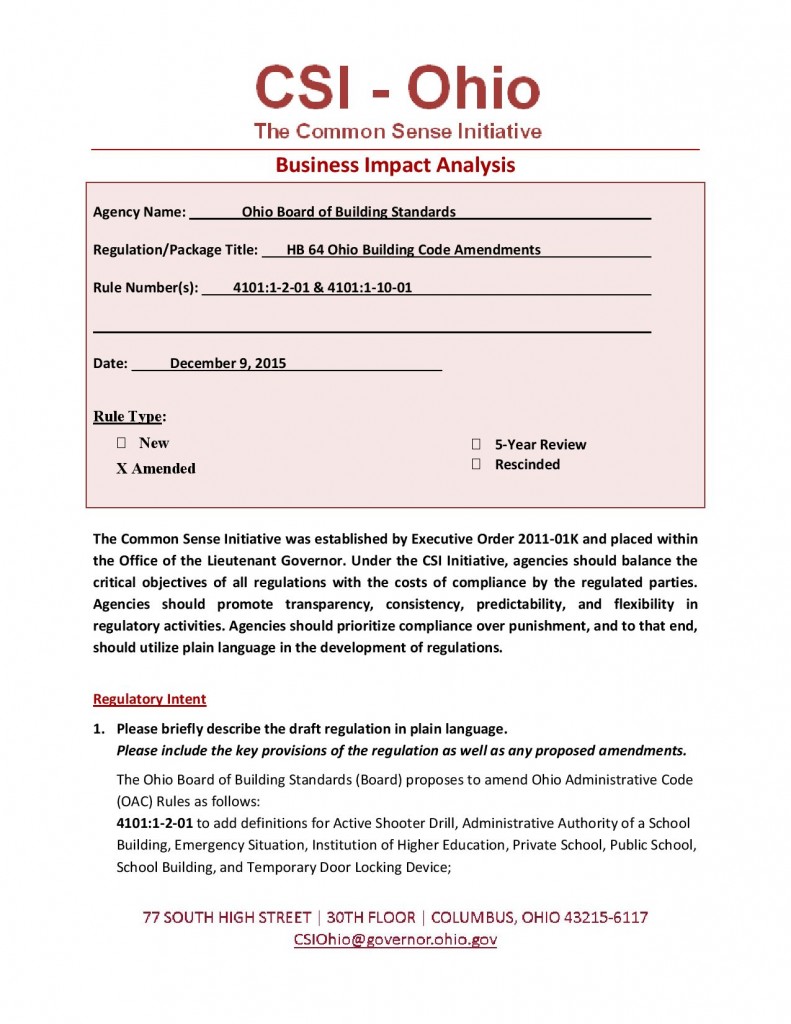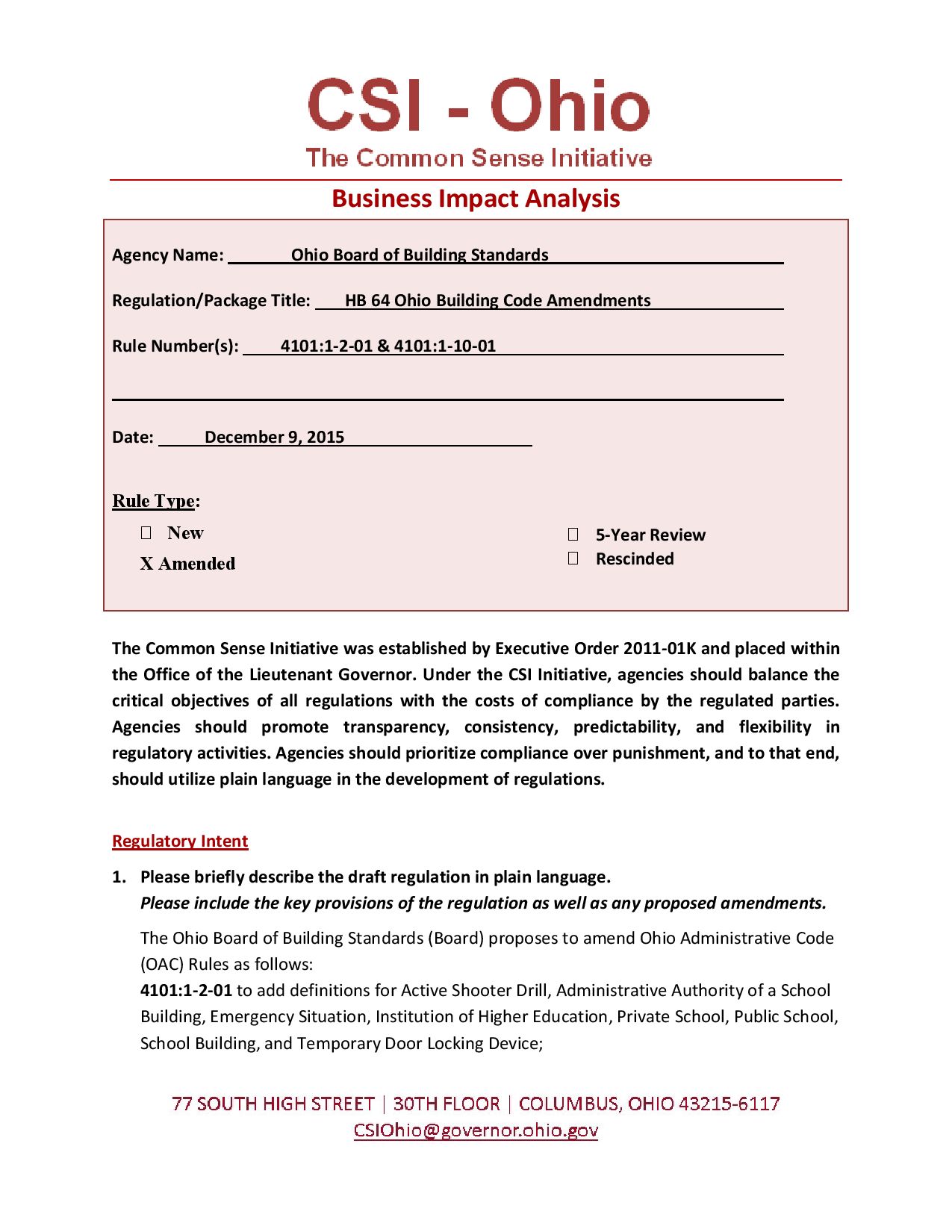 Last week, the Ohio Board of Building Standards posted a 434-page business impact analysis containing all of the comments submitted with regard to the proposed code change on classroom barricade devices. My comments to the board included a comparison of the recommendations made in the July 2015 OBBS Final Report vs. the proposed code language. There are numerous conflicts between what the OBBS recommended and the changes that could soon become part of the Ohio code. The OBBS response to my comments was basically the same as their response to the other comments, including those submitted by the AIA, NFPA, PASS, and close to 20 others:
Last week, the Ohio Board of Building Standards posted a 434-page business impact analysis containing all of the comments submitted with regard to the proposed code change on classroom barricade devices. My comments to the board included a comparison of the recommendations made in the July 2015 OBBS Final Report vs. the proposed code language. There are numerous conflicts between what the OBBS recommended and the changes that could soon become part of the Ohio code. The OBBS response to my comments was basically the same as their response to the other comments, including those submitted by the AIA, NFPA, PASS, and close to 20 others:
“Lori Greene submitted written comments included in the attached Exhibit C. Ms. Greene’s comments compared the draft rules with the Board’s Classroom Barricade Forum Report issued by the Board on July 24, 2015. The Board’s Code Committee reviewed the comments and information submitted by Ms. Greene and determined not to make a change as a result of the comment. While the Board does not disagree with Ms. Greene’s analysis, any changes that would be made based on the comments or the Board’s report would be inconsistent with the mandate established by the Ohio General Assembly in Revised Code § 3781.106. See response to Question 11 and the Board’s July 24, 2015 Classroom Barricade Forum Report attached as Exhibit D.”
The response to Question 11 referenced above basically says that the law passed in Ohio last summer defines many of the prescriptive requirements regarding the use of classroom barricade devices, therefore, the OBBS had no other option but to include these requirements in the code. This information is on pages 8 and 9 of the business impact statement. The OBBS understands the concerns and potential problems with the use of these devices, but legislators with little or no experience in code development or codes in general are now writing the codes. If this practice continues, it will undermine the established code development process and impact life safety of building occupants.
The revised code change proposals are available on this page of the Ohio.gov site (in the second section down, called Division of Industrial Compliance / Ohio Board of Building Standards Ohio Building Code). The Ohio BBS is taking comments on the proposed amendments until January 8, 2016. You may submit your comments via email or U.S. Mail at Ohio Board of Building Standards, 6606 Tussing Rd, Reynoldsburg, Ohio 43068, Attn: Regina Hanshaw.
So now what? I’m open to any and all ideas to help the legislators understand the issues in hopes that the law will be changed.
You need to login or register to bookmark/favorite this content.






If a state legislator revises a building code, does that code then become a law? How much authority do they have over code councils/committees that develop codes?
The laws in Ohio and Arkansas (the only 2 laws like this that I know of so far) override the State Fire Marshal and state codes. Sound like a good idea to you?
NO!
I am highly concerned with this trend.
Me too.
So, wiser and cooler heads have not yet prevailed. Perhaps, then, Ohio can test-drive their decision and beta-test a school with selected barricading devices and an intruder drill. Include a mock fire and mock hostage scenario. Have cameras rolling, let the media have the video files, let parents better understand the import of their collective decision via their legislators. None of us want to hear “It seemed like a good idea at the time…” at funerals.
I highly doubt Ohio would be willing to do that. I just hope the first kid to use one of these devices to take hostages isn’t heavily armed.
– Lori
good idea Tom.
Regrettably,the time for public input to change the outcome of the bill has long past. Now we get to wait for the game of roulette to start unless you can fund a legal challenge against a legislature.
When the law goes wrong there will be an outcry, and the finger point will begin, then the written statements and the record will be key, the statements by the board that they have little choice I seems to be correct as they are being directed by the law.
If there is time, (and there may not be), lobbyists from the trade and professional associations should get involved. The game being played is not about truth or saving lives, it’s about political expediency. Get people on it who know how to play.
An individual state legislator would not have the authority to make changes to the building code, but statutes passed/signed by the legislature/governor can overrule building code in any way the legislature/governor see fit. If the legislature were to pass a statute requiring that fire doors be covered on both sides with half an inch of exposed flammable foam, such a statute would be law until shortly after the morons who voted for it got replaced (probably at the next election) and a new legislature repealed the requirement. Of course, even if such a stupid law were passed, it’s may well decide to ignore it, and be able to summon enough political support to withstand efforts to terminate them for “dereliction of duty”.
This should not be a surprise, this ignorance about school fire safety seems to be resurface about every 50 years.
1918 quarterly NFPA Journal
https://books.google.com/books?id=-Q8bAQAAIAAJ&pg=PA20&lpg=PA20&dq=fire+protection+for+schools+h+w+forster&source=bl&ots=gOR1mf7ec8&sig=5jPbuVprLAHLRq1OsRJy7bWvrgw&hl=en&sa=X&ved=0ahUKEwiB7_TW0d7JAhWL4IMKHXmTAD4Q6AEIHTAB#v=onepage&q=fire%20protection%20for%20schools%20h%20w%20forster&f=false
1958 Our Lady Of The Angels School Fire
http://www.olafire.com/Coroner.asp
You are absolutely right.
– Lori